The PLC program assists farmers in times of low national prices, issuing payments when the market year average (MYA) price of a commodity falls below the corresponding effective reference price. The effective reference price was introduced in the 2018 farm bill as part of a mechanism that allows for changes to the reference price based on past MYA prices, often referred to as the “price escalator.” Notably, the effective reference price is capped at 115% of the statutory reference price, which was established in the 2014 farm bill and has remained unchanged since. Through 2023, the program year explored in this Market Intel, the price escalator had only been activated for eight crops with little base acreage; the largest of these was temperate japonica rice with only 336,260 enrolled base acres in 2023 (comprising just 0.1% of total enrolled base acres). In 2024, the effective reference price escalator activated for the first time for major crops – including corn, soybeans, grain sorghum and oats.
Of the 23 commodities covered by the Title I commodity programs, the only crop confirmed or projected to receive a 2023 PLC payment is rapeseed. Rapeseed also happens to be the smallest crop based on enrolled base acres – with only 2,355 acres, representing 0.001% total base acres.
ARC-CO Payments
ARC-County (ARC-CO) issues payments when actual revenue falls below 86% of benchmark revenue in a specific county. Benchmark revenue is calculated using a national benchmark price and county-level benchmark yield, which are each calculated using an Olympic average of the five years preceding the current year. As the 2023 MYA price across all covered commodities was equal to or above the 2023 ARC-CO benchmark price, the minimum county-average yield losses required to trigger a payment at the county level ranged between 13.3% for rapeseed and 57.7% for mustard seed. That is, for an ARC-CO payment to be triggered for mustard seed, an individual county had to see yields fall by at least 57.7% from the county’s calculated benchmark yield.
Summary of Payments
Using the methodology described in the “Data and Analysis” section below, we estimate approximately 27 million enrolled base acres are eligible to receive an ARC-CO payment for the 2023 crop year. This represents 18% of all ARC-CO enrolled base acres. Combined with the PLC payment for rapeseed, approximately 11% of all enrolled base acres will have received an ARC-CO or PLC payment. Notably, there are over 17 million PLC-enrolled base acres in counties that triggered an ARC-CO payment that will receive no payment for the 2023 crop year. This shows how important, and difficult, enrollment decisions are. In years where commodity prices are expected to be high, and thus PLC is unlikely to be triggered, some farmers who typically elect PLC should consider electing ARC-CO.
The following table displays the effective reference price, MYA price, ARC-CO benchmark price, minimum required decline in yield for ARC-CO payment at the county level, and the percentage of total enrolled base acres assigned to each crop.
Note the differences between the ARC-CO benchmark price and the effective reference price in Table 1. Due to how it is calculated, the ARC-CO benchmark price is more flexible and more responsive to the changing long-term price landscape than the effective reference price, which is used to determine PLC payments. The effective reference price has not kept up to escalating prices and costs, one of the main reasons that many farm groups, including the American Farm Bureau Federation, are advocating for higher reference prices for all crops in a future farm bill.
Conclusion
Despite the elevated commodity prices in 2023, many farmers still lost money on every acre they planted due to high input costs; but only approximately one in 10 base acres will receive a Title I payment. In 2024, farmers will face even steeper losses. They will lose significant money on every acre they plant and the outdated safety net will not catch them.
Data and Analysis
The following table and maps will review the ARC-CO and PLC payments for each covered commodity based on FSA data published on Oct. 31, 2024. ARC-CO payment rates are displayed in dollars per acre. For counties with both irrigated and non-irrigated designations, the designation with the higher ARC-CO payment is displayed. Please note that if a payment is triggered for one designation, it does not mean that it is triggered for the other. For instance, non-irrigated corn in Cuming County, Nebraska, will receive an ARC-CO payment of $85.16 per acre, while irrigated corn in the same county will not receive a payment.
For each commodity, we estimate enrolled acres qualifying for an ARC-CO payment. This estimate is calculated using the ARC-CO enrolled acres for counties identified as having a payment. We cannot pinpoint the exact acreage for two main reasons. First, data on county-level enrollment for irrigated and non-irrigated designation by acreage is not available. All enrolled ARC-CO base acres are included in this figure, even if only one of the two designations triggered payment, which may cause us to overestimate acreage with a payment. Using corn in Cuming County, Nebraska, again, all 123,197 ARC-CO enrolled base acres are designated as triggering a payment in the following commodity summaries. However, an unknown portion of these acres are likely designated as irrigated – and would not actually receive a payment.
Secondly, some ARC-CO and PLC acres are not assigned to an individual county in available FSA data and are instead lumped into a national “undisclosed” figure, which results in the data potentially missing some acres that receive ARC-CO payments. The impact of undisclosed acres would lead to an underestimation, with impacts varying substantially from crop to crop. The most impacted crop on a percentage basis is long grain rice, which has nearly 12,000 acres of ARC-CO enrolled acres in an undisclosed location, comprising 61% of all enrolled ARC-CO acres for that crop. Meanwhile, corn has the highest amount of undisclosed location ARC-CO acres at over 47,000, but those represent only 0.2% of total ARC-CO-enrolled corn acres.
This Market Intel was inspired by, and expands upon, FarmDoc Daily’s “2023 ARC-CO and PLC Payments for Corn, Soybeans, and Wheat” by Nick Paulson, Gary Schnitkey, Jonathan Coppess and Carl Zulauf.
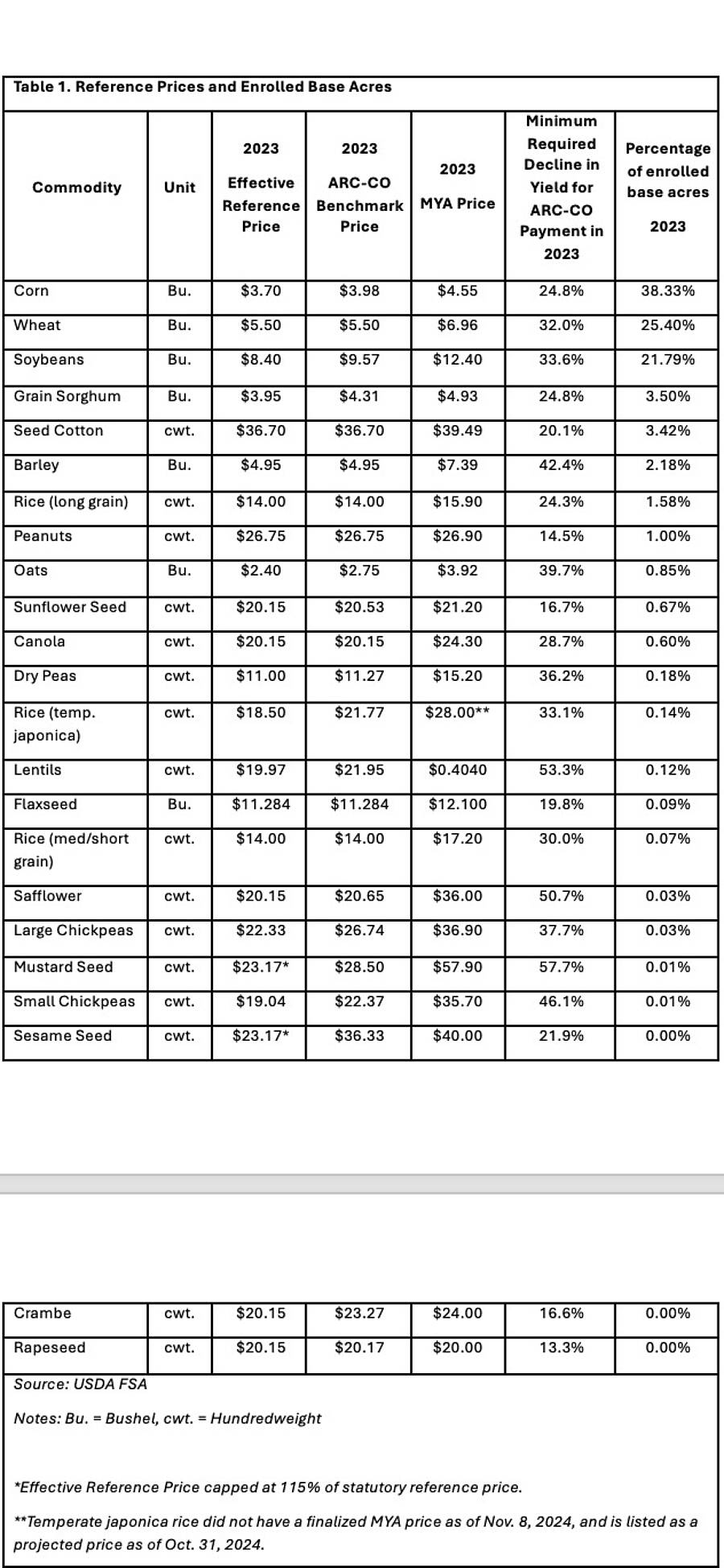
Corn
A total of 254 counties across 32 states qualified for ARC-CO payments for corn, representing 10% of counties with Farm Service Agency (FSA)-reported payment rates. Over 5.5 million acres were identified as being both enrolled in and qualifying for an ARC-CO payment, representing 6% of total enrolled corn base acres.
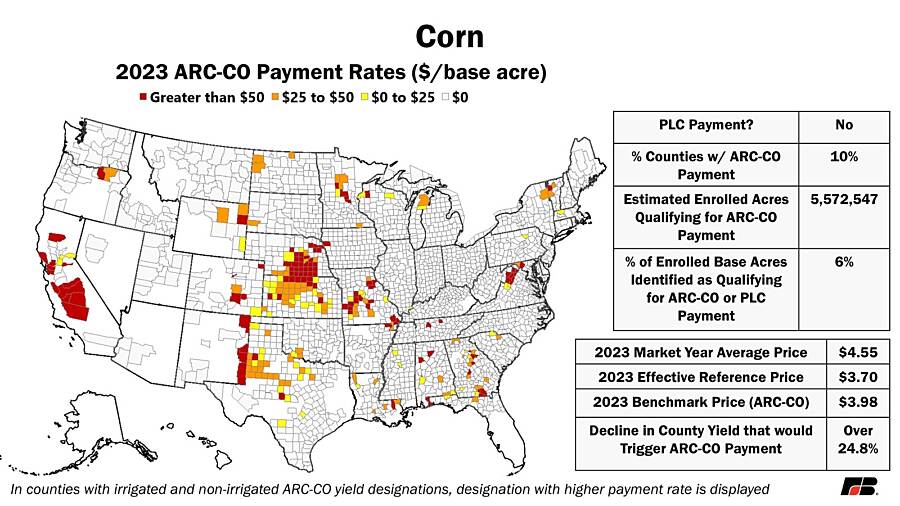
Wheat
A total of 352 counties across 26 states qualified for ARC-CO payments for wheat, representing 14% of counties with FSA-reported payment rates. Over 12.9 million acres were identified as being both enrolled in and qualifying for an ARC-CO payment, representing 21% of total enrolled wheat base acres.
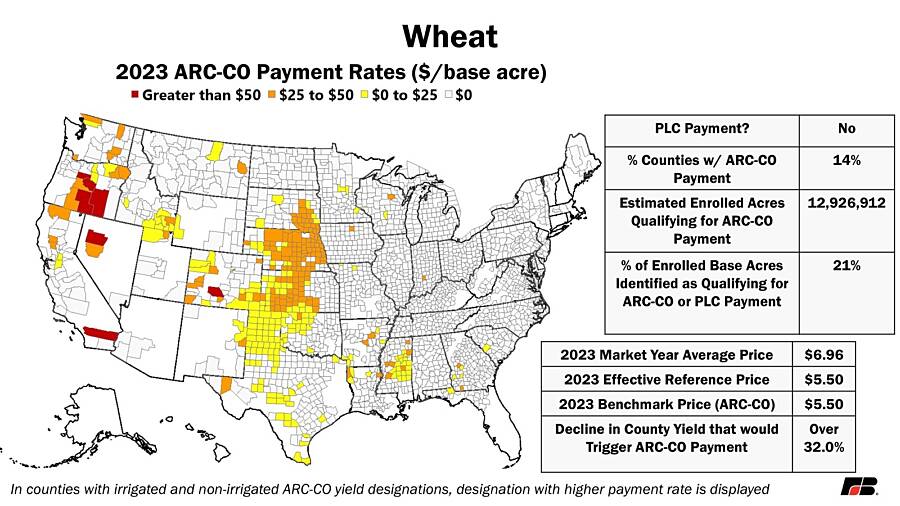
Soybeans
A total of 254 counties across 23 states qualified for ARC-CO payments for soybeans, representing 12% of counties with FSA-reported payment rates. Nearly 3.2 million acres were identified as being both enrolled in and qualifying for an ARC-CO payment, representing 6% of total enrolled soybean base acres.
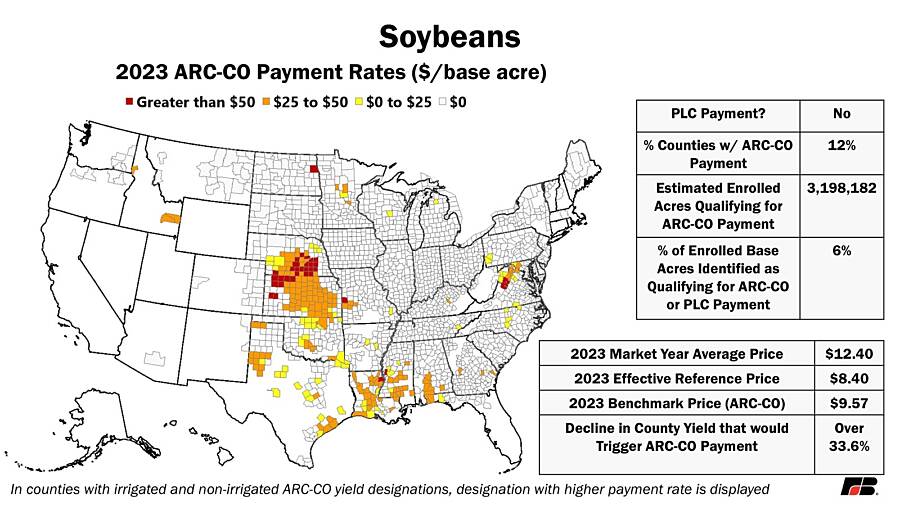
Grain Sorghum
A total of 488 counties across 24 states qualified for ARC-CO payments for grain sorghum, representing 26% of counties with FSA-reported payment rates. Over 2.9 million acres were identified as being both enrolled in and qualifying for an ARC-CO payment, representing 35% of total enrolled grain sorghum base acres.
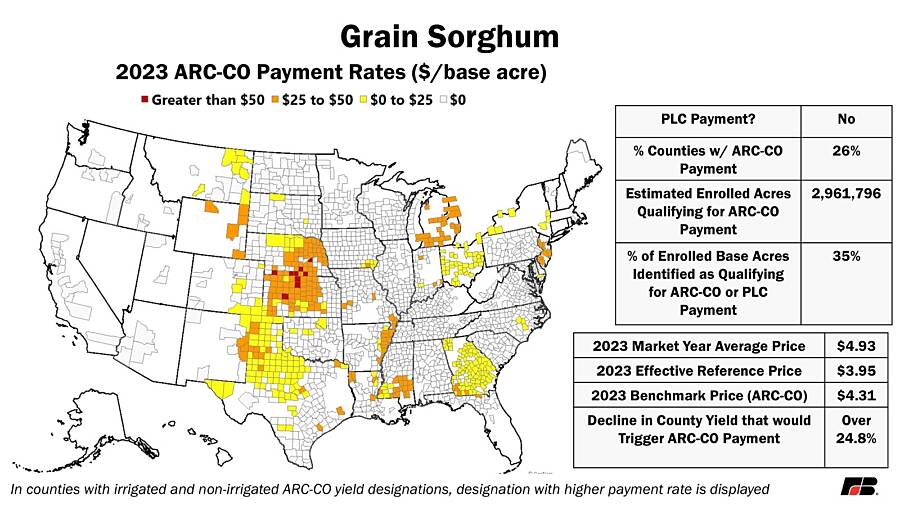
Seed Cotton
A total of 214 counties across 11 states qualified for ARC-CO payments for seed cotton, representing 40% of counties with FSA-reported payment rates. Over 1.6 million acres were identified as being both enrolled in and qualifying for an ARC-CO payment, representing 20% of total enrolled seed cotton base acres. Notably, there were more PLC-enrolled base acres in the ARC-CO-payment-qualifying counties, at 1.9 million PLC-enrolled base acres.
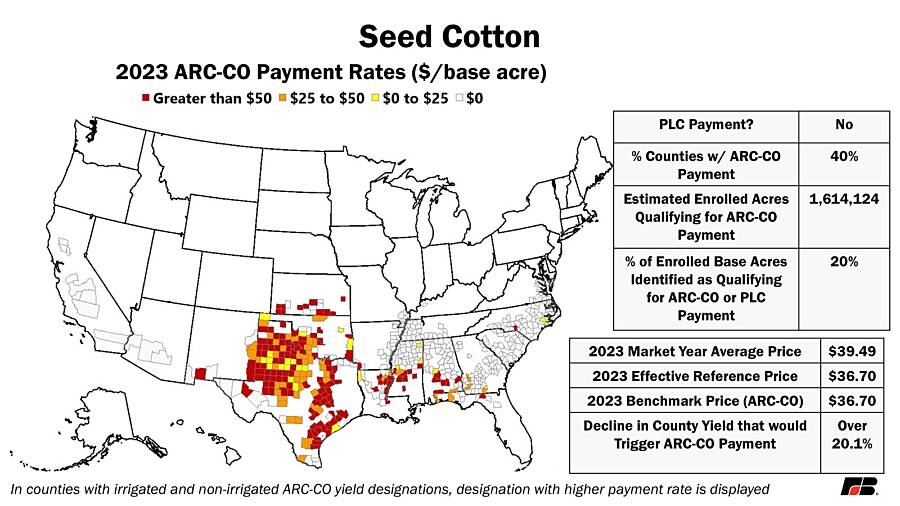
Barley
A total of 27 counties across 12 states qualified for ARC-CO payments for barley, representing nearly 2% of counties with FSA-reported payment rates. Less than 70,000 acres were identified as being both enrolled in and qualifying for an ARC-CO payment, representing nearly 1% of total enrolled barley base acres.
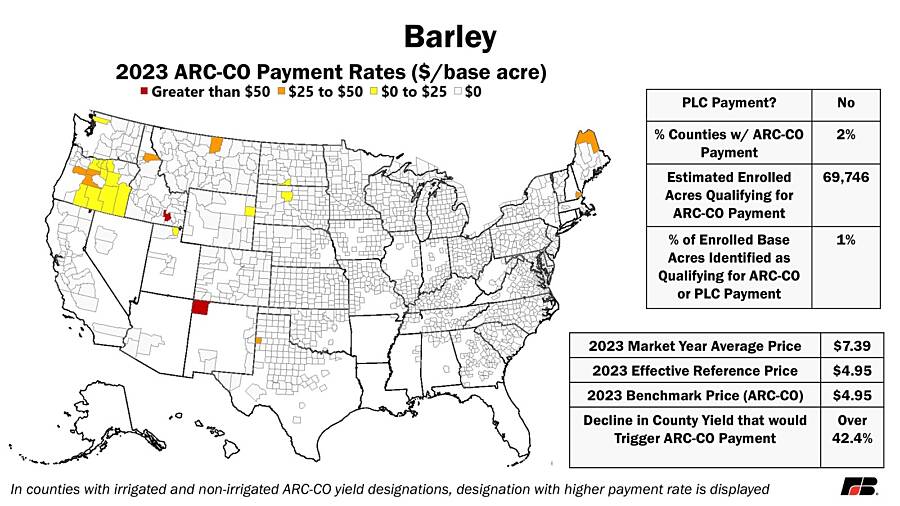
Long Grain Rice
A total of four counties across Mississippi, California and Arkansas qualified for ARC-CO payments for long grain rice, representing 6% of counties with FSA-reported payment rates. Only 330 acres were identified as being both enrolled in and qualifying for an ARC-CO payment, representing only 0.01% of total enrolled long-grain rice base acres. In 2023, 99.6% of all long grain rice base acres nationwide were enrolled in PLC, the highest percentage of any covered commodity.
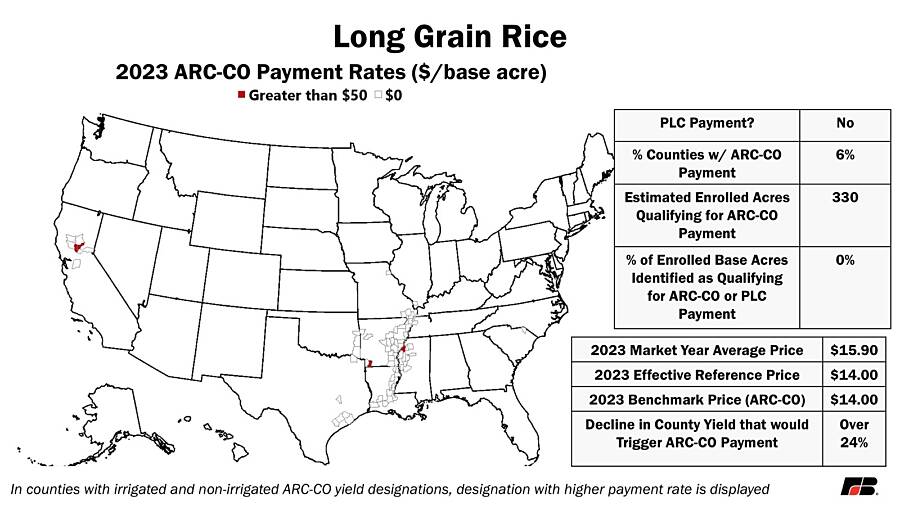
Peanuts
A total of 59 counties across seven states qualified for ARC-CO payments for peanuts, representing 31% of counties with FSA-reported payment rates. Slightly over 23,000 acres were identified as being both enrolled in and qualifying for an ARC-CO payment, representing only 1% of total peanut base acres. In 2023, 98.4% of all peanut base acres nationwide were enrolled in PLC.
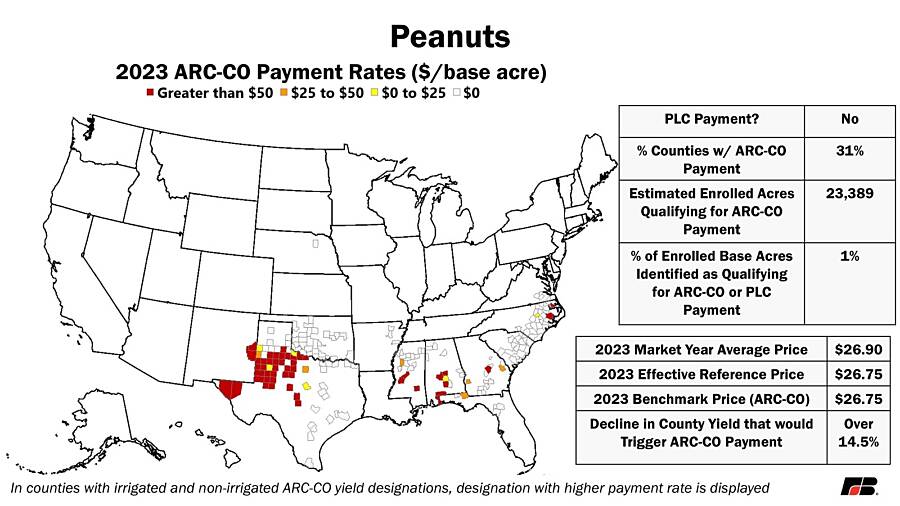
Oats
A total of 66 counties across 13 states qualified for ARC-CO payments for oats, representing 3% of counties with FSA-reported payment rates. Nearly 68,000 acres were identified as being both enrolled in and qualifying for an ARC-CO payment, representing 3% of total enrolled oat base acres.
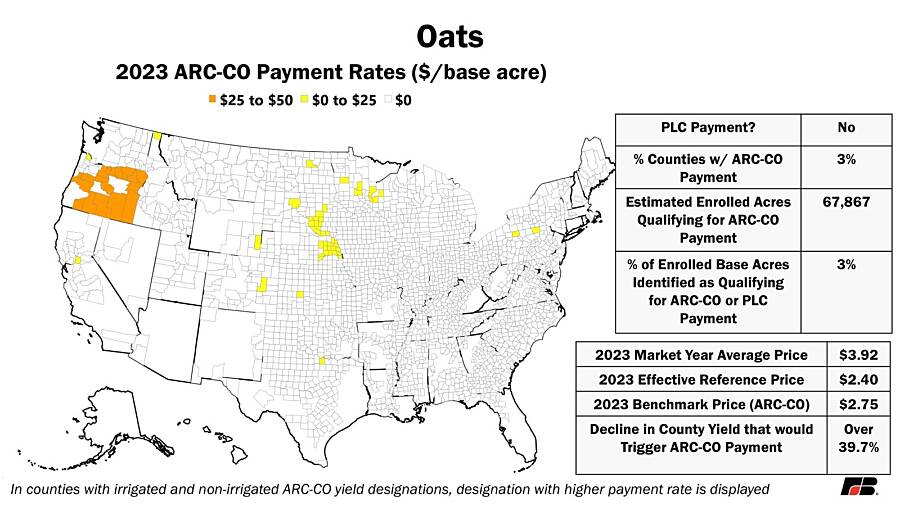
Sunflower Seed
A total of 189 counties across 13 states qualified for ARC-CO payments for sunflower seed, representing 21% of counties with FSA-reported payment rates. Nearly 225,000 acres were identified as being both enrolled in and qualifying for an ARC-CO payment, representing 14% of total enrolled sunflower seed base acres.
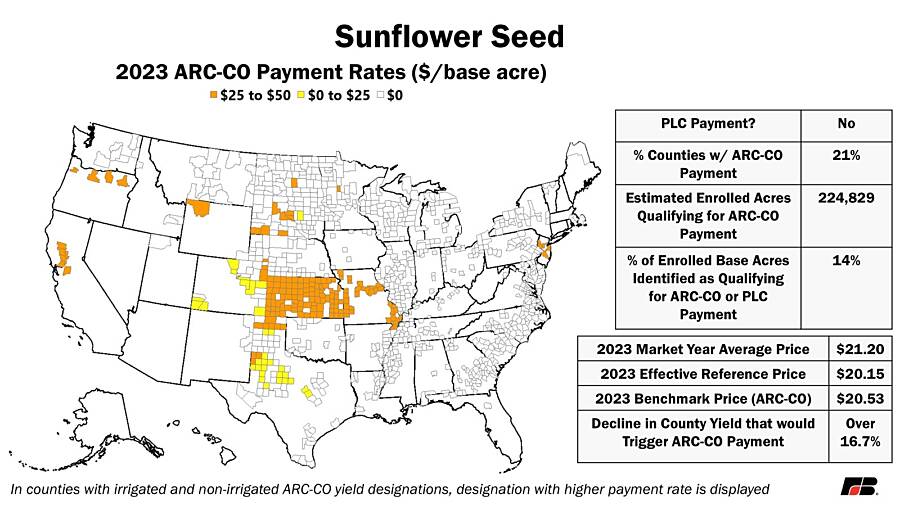
Canola
A total of 44 counties across eight states qualified for ARC-CO payments for canola, representing 15% of counties with FSA-reported payment rates. Nearly 17,000 acres were identified as being both enrolled in and qualifying for an ARC-CO payment, representing over 1% of total enrolled canola base acres.
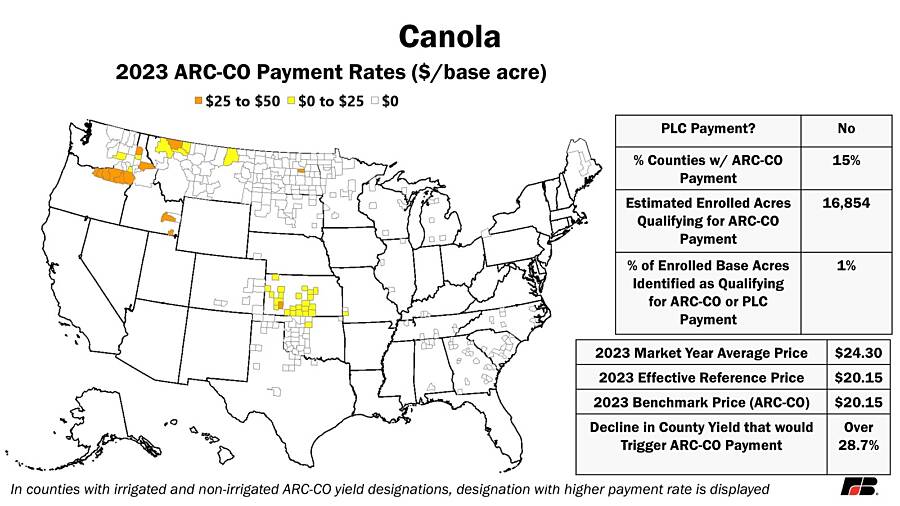
Dry Peas
A total of 31 counties across six states qualified for ARC-CO payments for dry peas, representing 13% of counties with FSA-reported payment rates. Nearly 11,000 acres were identified as being both enrolled in and qualifying for an ARC-CO payment, representing nearly 3% of total enrolled dry pea base acres.
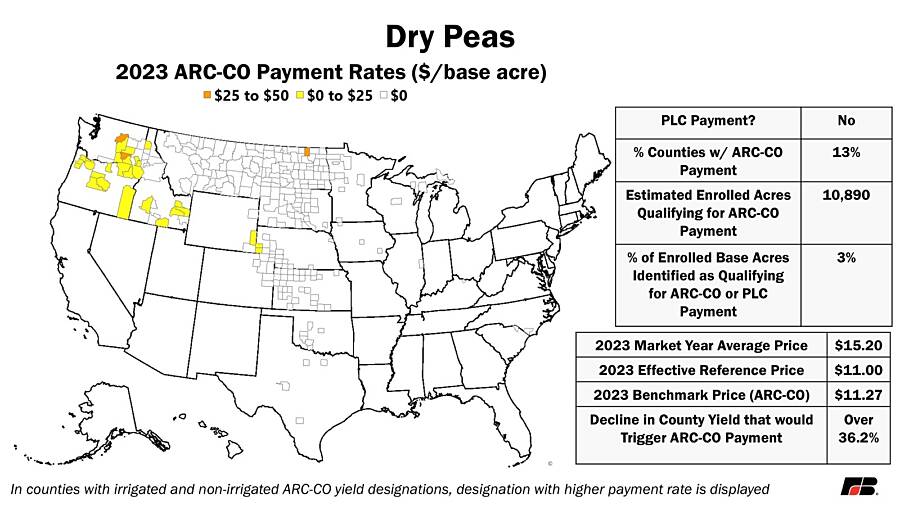
Temperate Japonica Rice
Finalized 2023 MYA price data is not yet available for temperate japonica rice, so county-level ARC-CO payments are also not yet available. At the projected MYA price of $28 per cwt, a yield decrease of over 33.1% would be necessary to qualify a county for an ARC-CO payment, and no counties will qualify for a payment. Temperate japonica rice would not qualify for a PLC payment, as the 2023 effective reference price is only $18.50.
Lentils
Only one area in Idaho, defined as Kootenai-North Shoshone by FSA, qualified for an ARC-CO payment for lentils, representing 1% of counties with FSA-reported payment rates. Nearly 2,000 acres were identified as being both enrolled in and qualifying for an ARC-CO payment, representing less than 1% of total enrolled lentil base acres.
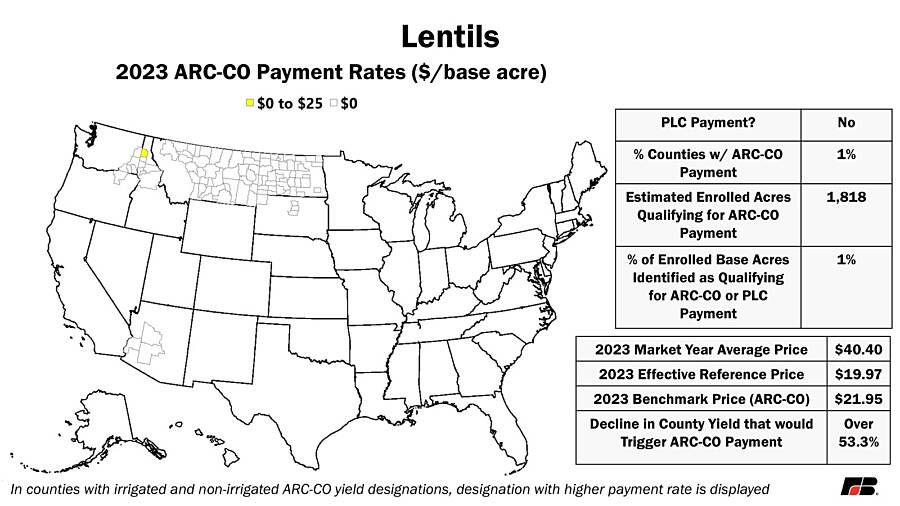
Flaxseed
A total of 30 counties in Washington, Montana, North Dakota and Wisconsin qualified for ARC-CO payments for flaxseed, representing 21% of counties with FSA-reported payment rates. Over 13,000 acres were identified as being both enrolled in and qualifying for an ARC-CO payment, representing nearly 6% of total enrolled flaxseed base acres.
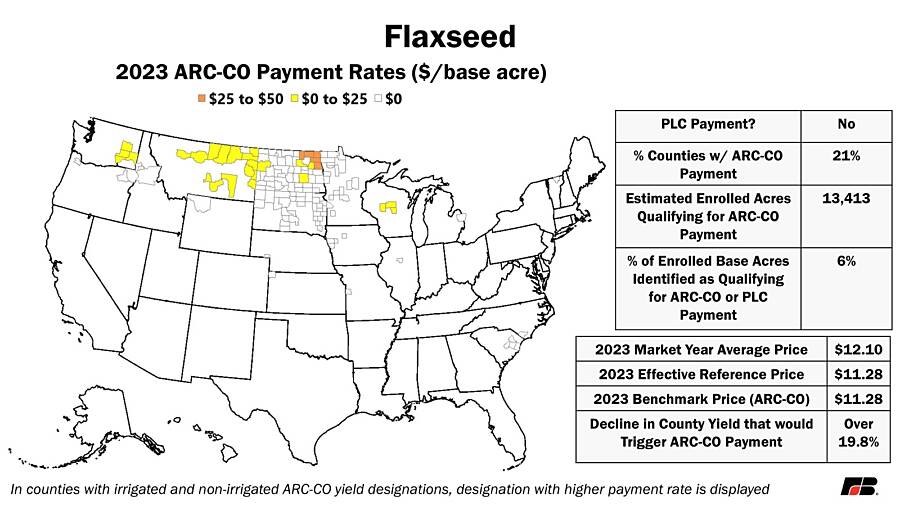
Medium/Short Grain Rice
Only five counties in Arkansas and Louisiana qualified for ARC-CO payments for medium/short grain rice, representing 15% of counties with FSA-reported payment rates. There are no acres identified as being both enrolled in and qualifying for an ARC-CO payment. There are over 5,000 acres of PLC-enrolled base acres in the five qualifying counties, representing 3% of total enrolled medium/short grain rice base acres.
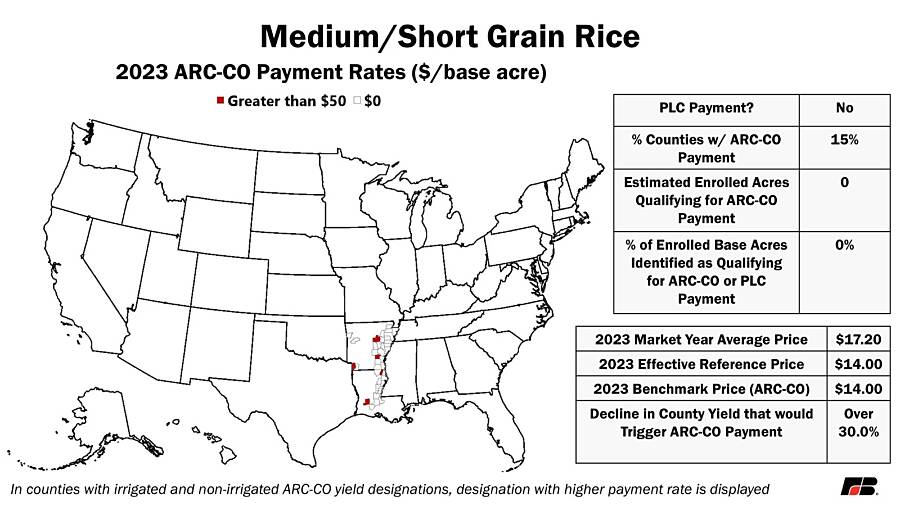
Safflower
There were no counties identified as qualifying for an ARC-CO payments for safflower. High prices in safflower meant that a county would have needed a yield loss of over 50.7% to qualify for an ARC-CO payment.
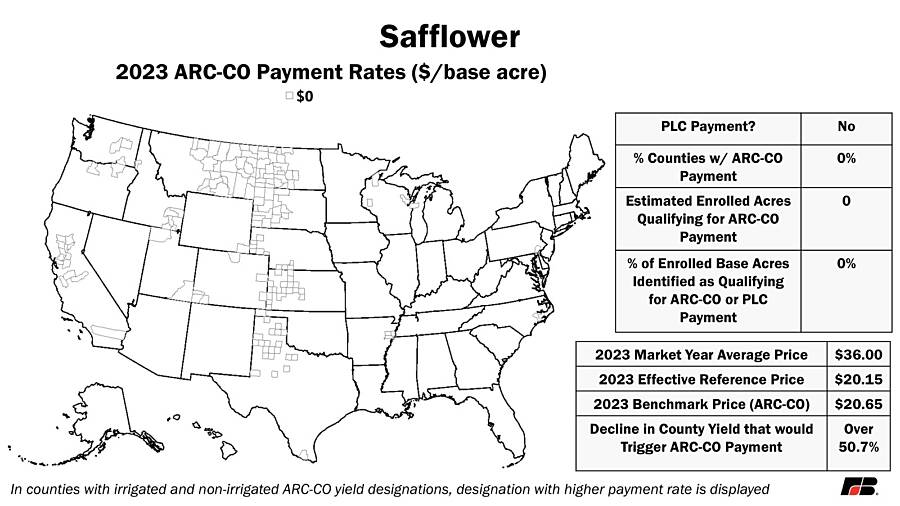
Large Chickpeas
Only Gem County, Idaho, qualified for ARC-CO payments for large chickpeas, representing 1% of counties with FSA-reported payment rates. There were no enrolled ARC-CO base acres in that county, so no large chickpea base acres qualified for a payment.
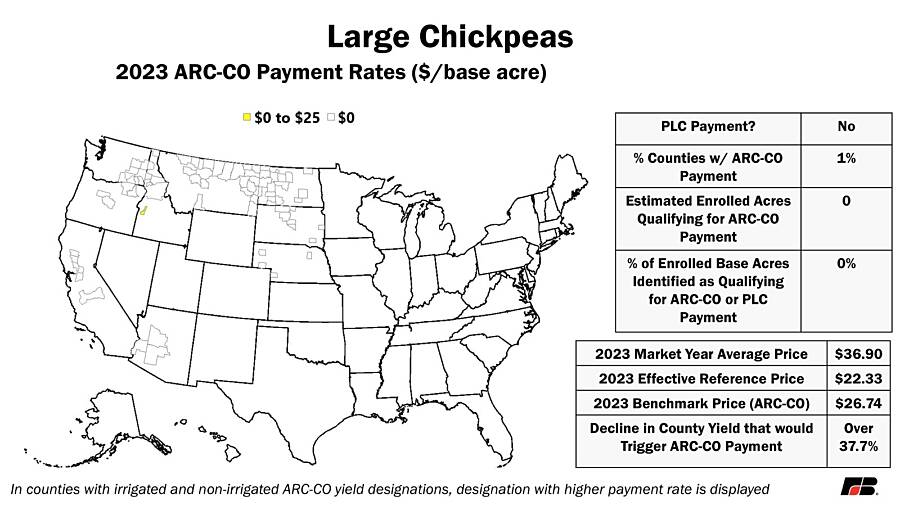
Mustard Seed
Only two counties, one in Montana and one in Kansas, qualified for ARC-CO payments for mustard seed, representing 3% of counties with FSA-reported payment rates. Only 373 acres were identified as being both enrolled in and qualifying for an ARC-CO payment, representing nearly 2% of total enrolled mustard seed base acres. Of all the covered commodities, mustard seed had the highest required drop in county yields to trigger a payment due to mustard seed prices.

Click here to see more...